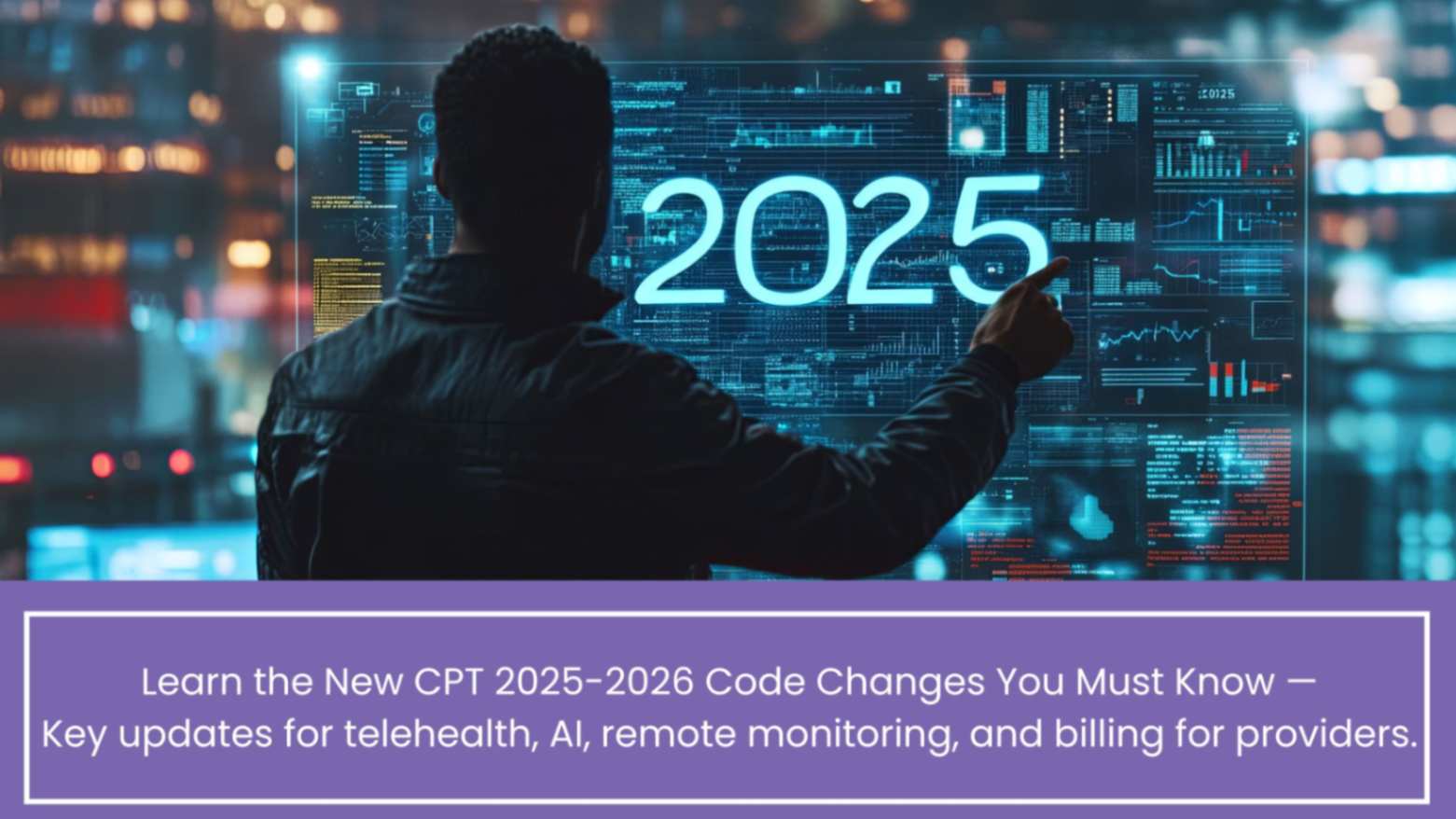New CPT 2025-2026 Code Changes You Must Know
We bring you this essential guide on New CPT 2025-2026 Code Changes You Must Know—a carefully curated breakdown of updates that will directly impact your billing, compliance, and revenue integrity. In healthcare, the only constant is change — and coding is no exception. This year’s updates touch everything from CPT updates for providers to the newest telehealth CPT code updates 2025 and even the first wave of AI CPT codes 2026. Whether you’re a doctor, a biller, or an insurance rep, you’ll find what’s new, what’s gone, and how to get ahead of it all right here.
At Practolytics, we believe staying current is not optional. That’s why we bring you this essential guide on New CPT 2025-2026 Code Changes You Must Know—a carefully curated breakdown of updates that will directly impact your billing, compliance, and revenue integrity. In healthcare, the only constant is change — and coding is no exception. This year’s updates touch everything from CPT updates for providers to the newest telehealth CPT code changes for 2025 and even the first wave of AI CPT codes 2026. Whether you’re a doctor, a biller, or an insurance rep, you’ll find what’s new, what’s gone, and how to get ahead of it all right here.
Table of Contents
Introduction:
Every year, the American Medical Association (AMA) refreshes the CPT (Current Procedural Terminology) codes to keep up with new tech, new care models, and new rules. These AMA CPT updates aren’t just paperwork — they’re the universal language we all use to document services and get reimbursed. Miss a change and you risk denied claims, compliance problems, and lost revenue.
So who really needs to pay attention? Pretty much everyone in the healthcare money chain:
- Providers need the right codes to make sure they’re paid correctly.
- Coders and billing teams need to apply these changes correctly so claims don’t get held up or denied.
- Payers — whether that’s insurers, Medicare, or Medicaid — have to update their rules and payment policies to match.
- Health systems, RCM vendors, and auditors also need to adjust their systems, workflows, and compliance checks to stay in step with the new codes.
Here at Practolytics, our goal is to make those shifts easier for you. In this blog, we break down the New CPT 2025-2026 Code Changes You Must Know — from new codes and deletions to specialty-specific updates — and answer common questions so your practice stays compliant and your revenue stays healthy.
Key Highlights of CPT 2025-2026 Updates
This section captures the most notable shifts in the new cycle. These changes affect telehealth, remote monitoring services, AI, code clarity, and compliance thresholds.
New Code Additions (e.g., AI, telehealth, RPM/RTM)
- New AI and augmented intelligence codes will formalize how you bill for machine-assisted diagnosis, interpretation, and clinical decision support.
- Telehealth expansion includes new codes (e.g. 98000–98016) to reflect virtual care services with more granularity.
- Remote monitoring / RTM codes are expanded with new tiers, refined thresholds, and device classifications to reflect advanced monitoring tools (wearables, sensors).
These new additions are central to CPT updates for providers, telehealth CPT code updates 2025, and AI CPT codes 2026.
Code Deletions (e.g., telephone-only codes)
- A number of the old audio-only phone visit codes are on their way out. With telehealth now the norm, many of those “telephone-only” codes are being retired or rolled into new, broader telehealth codes.
- You’ll also see some outdated or rarely used codes disappear completely. AMA is cleaning house, so the CPT book better reflects how care is actually delivered today — making the code set clearer and easier to use.
Code Revisions (documentation, tumor size, vascular procedures)
- Several existing codes receive revised definitions or descriptors. For instance, tumor measurement cutoffs or staging documentation may change.
- Vascular and surgical codes get refined modifiers, inclusion/exclusion notes, and updated bundling logic.
- Documentation requirements may tighten, especially for risk stratification, medical necessity, and AI-assisted workflows.
Specialty-Specific CPT Changes
Here are key changes by specialty area that you and your coders must watch.
Telehealth & Virtual Care (new 98000–98016 codes):
- The new series 98000–98016 are specifically created to delineate telehealth CPT code updates 2025 for modalities like video visits, remote consults, and hybrid care.
- These codes will specify modality (audio/video), duration, and complexity.
- Many payers will require different documentation rules for telehealth vs in-person, making adherence essential.
Remote Monitoring & RTM Codes:
- Remote monitoring CPT 2026 additions refine thresholds (e.g., minimum data days, alert settings) to qualify for reimbursement.
- Codes may distinguish between remote physiologic monitoring (RPM) vs remote therapeutic monitoring (RTM).
- Some codes will now bundle device supply, installation, and data analysis into new bundled or add-on codes.
AI & Augmented Intelligence in CPT 2026:
- New codes will allow billing for AI-based image interpretation, report augmentation, and algorithmic support tools.
- However, stringent documentation and validation requirements will apply—clinicians must record how AI influenced decisions, and disclaim responsibility for algorithm errors.
- Payers will monitor these usage patterns for appropriateness, making audit risk higher for misuse.
Hearing Device & Audiology Services
- Updates will adjust how hearing aids, cochlear implants, and diagnostic audiology services are coded (especially when interfacing with remote tuning or tele-audiology).
- Certain add-on codes specific to device programming or remote adjustments may be introduced or retired.
Radiology & Imaging Updates:
- Imaging codes may be expanded for advanced modalities (e.g., AI-assisted CT/MRI interpretation) or refined for dose metrics and contrast use.
- New modifiers may delineate AI-assisted reads vs fully manual interpretation.
- Bundling rules for imaging plus interventional procedures may change in vascular and neuroimaging domains.
Surgery & Vascular Revisions:
- Surgical procedures (especially vascular, transplant, reconstructive) may have revised complexity tiers and inclusion notes.
- Some additive code segments are introduced to reflect robotics, AI-assisted planning, or intraoperative imaging.
- Documentation expectations around lesion size, approach type, and vascular anatomy will tighten.
PLA & Lab Code Changes
New PLA codes for 2025-2026:
- The Proprietary Laboratory Analyses (PLA) code set is expanded to cover newly recognized tests, diagnostics, assays, and AI-driven lab interpretation.
- Laboratories must submit new PLA codes for FDA-cleared or CLIA-validated tests; payers will adopt or reject them individually.
- These CPT updates for providers in labs will especially affect pathology, molecular diagnostics, and genomic panels.
CMS effective dates and payer adoption:
- Though AMA publishes code changes, CMS effective dates (and payer adoption) may lag or vary across commercial plans.
- Some payers may delay acceptance of new PLA or AI codes or restrict them by policy.
- Practices must monitor payer bulletins to know when New CPT 2025-2026 Code Changes You Must Know go live in their network.
Provider FAQs on CPT 2025-2026
Below are some frequently asked questions to help clarify common concerns:
What new CPT codes take effect in 2026?
The new AI interpretation codes, expanded RTP/RMT codes, and telehealth modalities (98000–98016) are slated for implementation in 2026. Always check CMS and payer release updates to confirm exact effective dates.
How do telehealth CPT changes affect audio-only visits?
Many legacy telephone-only codes are being deprecated or reclassified. Payers may no longer reimburse audio-only visits unless under special exceptions or qualifiers—they may demand video or hybrid codes instead.
What documentation is required for new AI codes?
Clinicians must record how the AI output influenced clinical decisions, the algorithm version, and disclaim any errors. You may also need to annotate the degree of human oversight, validation data, and decision logic.
Which payers are covering new PLA codes?
Payer adoption is inconsistent—some commercial and Medicare Advantage plans may accept new PLA codes immediately, while others delay or deny based on their own coverage policies. Check each payer’s coding bulletins.
What’s changing with RPM & RTM thresholds?
New remote monitoring codes will introduce updated minimum data capture days (e.g. 16 or 20 days), alarm thresholds, and device requirements. Some older codes may be retired or merged under stricter qualification rules.
Preparing Your Practice for CPT 2026
Implementation is the key. Here’s how we at Practolytics recommend you get ready:
EHR & billing system updates:
- Coordinate with your EHR, HIS, and billing vendor to load new code sets (98000–98016, PLA, AI, RPM/RTM) before the go-live.
- Make sure logic engines enforce correct bundling, prechecks, and edits for new codes.
Staff Training & Coding Education:
- Conduct educational sessions for providers, coders, audit teams, and billing staff on what has changed and how to document.
- Provide cheat sheets, decision trees, and example scenarios for telehealth CPT code updates 2025 and new AI or RPM codes.
Payer policy Monitoring:
- Track payer bulletins, commercial updates, and CMS releases about when and whether they will accept the changes.
- Maintain a matrix of payers vs code adoption and known denials or edits.
Best Practices for Audit & Compliance
- Pre-audit sample charts to validate correct use of new codes, documentation sufficiency, and avoid overuse.
- Incorporate new codes into your internal CPT 2026 billing compliance checklist.
- Monitor denials and appeals trends early—and flag pattern issues at scale.
Conclusion:
The New CPT 2025-2026 Codes are going to reshape how practices document, bill, and get paid — especially in areas like telehealth, remote monitoring, AI, and lab testing. If you’re a provider, coder, or part of a billing team, keeping up with these shifts isn’t optional anymore. Practolytics, we’re here to make all of this easier for you. We’ll handle the updates, training, and compliance so you can keep your revenue flowing and focus on your patients.
ALSO READ – Decoding CPT: Your Guide to Codes and Regulations 2024
Talk to Medical Billing Expert Today — Get a Free Demo Now!






